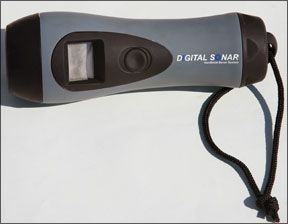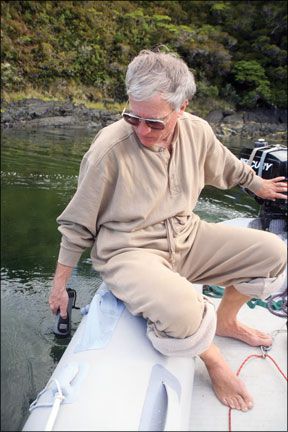When cruising off the beaten path, youre likely to come across harbors, channels, and other waterways that arent well charted. In these areas, a portable depth sounder becomes a necessary tool for safe navigation and anchoring.
The two products they tested were the Norcross HawkEye Portable Sonar System (DF2200PX) and Speedtech Instruments handheld depth sounder. Both are designed for use aboard a dinghy, through a fiberglass or wood hull, or through ice.

288
The multi-purpose Norcross can read depths from 2.5 to 200 feet, and also has a sensor that measures the temperature of the water, the air, or any object the sensor is placed against. It can also be used as a fishfinder. A fish icon appears on the screen with the depth when the sonar detects something other than the bottom in its field. The Hawkeye floats and is waterproof to 200 feet.
Starzinger and Leonard reported that through two months regular use, the Hawkeye proved to be highly reliable and ruggedly constructed, with a very comfortable grip.
The sounder worked equally well on hard rock bottoms and soft mud bottoms, but it had some problems in thick kelp-sometimes reading off the kelp and sometimes reading off the bottom. But in all cases, it gave readings that were as accurate as the boats onboard B&G depthsounder. The temperature readings in both air and water were found to be accurate and matched readings from other thermometers.

288
The fishfinding capability has yet to be tested.
The Hawkeye is powered by four AA batteries. In two months of nearly daily usage, the unit had no power dropoff and the batteries did not require replacing.
Speedtech Instruments sounder is one Starzinger and Leonard have been long-term testing, one they reported on in their 85,000-mile gear report card (Practical Sailor January 2007). It earned a C in that review as they found it to be accurate but not very robust. The first unit they tested lasted only a year, and the second developed intermittent issues around its first birthday. The problem seemed to be that the unit was not totally waterproof.
In two months of testing the Hawkeye, the testers found it to be fully waterproof and problem free. Only time will tell whether its more durable than the Speedtech sounder.
The Speedtech works on a single 9-volt battery, which is much harder to find in remote places than t
he AAs the Norcross HawkEye uses.The only criticism the testers had about the Norcross was that its activation button was not adequate: Pressed once, it shows depth, twice it gives temperature. When taking multiple depth readings, temperature comes up instead of depth on the second button push, unless users wait 10-15 seconds. Separate buttons would solve this problem.
The Hawkeye would benefit those who
use a dinghy to sound an anchorage, who scuba dive, fish from a small boat, or ice fish. The unit lists for $100 on www.norcrossmarine.com.While the long-term tests of these units continue in the far reaches of the world, stateside
Practical Sailor testers will be putting these and other portable depth sounders through their paces in bench tests and practical applications. Stay tuned.


































